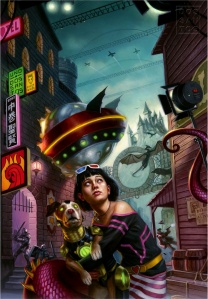One of the more ambitious things about INDIGARA by Tanith Lee is the way she tells the story. There are three separate voices: Jet, the main character; her robotic dog, Otis; and an omniscient stage director. So, being the anal-retentive scientist-type, I calculated out approximately how much of the book she spends in each point of view:
- Jet’s Point of View: 65%
- Omniscient Stage Director: 25%
- Otis, the robotic dog: 10%
The amount of space given to Jet’s point of view isn’t surprising. After all, it is a young adult book. One of the hallmarks of young adult is a teen protagonist. If you have multiple points of view, you’re supposed to indicate to the reader which is the most important by giving them the majority of the real estate in the book. And Tanith Lee does just that.
Jet has an interesting enough voice to carry the story. She sounds bored, sarcastic, and moody. My inner fourteen-year-old totally relates. One way that she makes the teenaged voice work is the liberal use of run-on sentences. Take this example:
Like I remember her crying years ago when she was only thirteen and I was only nine, and I crept out of bed and went to her bed and climbed in and put my arms around her, and then we both sobbed and I said, Turquoise, what’s wrong? And she said, I failed my exam. I loved her, and I said she was so wonderful it wouldn’t count if she failed all her exams because in the end she would be a great movie star.
I skimmed all of the sections from Jet’s point of view. While Ms. Lee does vary the sentence length with fragments and quick, short statements, long blocks of writing are run-on sentences like this one. And it worked to make the protagonist sound young.
I expected Otis to get the second largest percentage of the book. His narration was memorable. He was the quintessential huffy, overworked nanny. But obviously, he got the smallest percentage of the book. I think that the author had to make the decision to tell the story this way. Although Otis is a character who deserves more ‘screen time’ (so to speak), he’s also constantly at Jet’s side. His point of view isn’t so different from her point of view.
To offset the mere 10% we spend in Otis’s point of view, Ms. Lee gives him the first and last narration in the book. With this one strategic decision, she cements his importance without giving him much space. I thought it was brilliant.
On the other hand, the omniscient stage direction is a useful tool. First, it gives the reader a chance to look in on the real world when Jet goes into Indigara. Second, stage direction in a screenplay can be used to describe the setting. Ms. Lee uses that for that purpose in this book which is pretty sneaky, from a writer’s perspective. Third, the voice is so flat and matter-of-fact, when Jet’s doppelganger in the real world wreaks havoc; it’s that much more entertaining. Finally, when the point of view changes, there’s a header that announces it. The omniscient stage direction has a variety of amusing headers including The Surprise:Extra Scene, Diamind City:Montage, and Outtake. Honestly, if you skip over the headers, you miss a lot of humor. It helps keep the tone of the book light.
So, that’s INDIGARA by Tanith Lee. This book may not be for everyone but I enjoyed it. And it was a nice break from the deep and depressing that I seem to keep falling in love with. I’ll see everyone on Friday!
The cover art image is used with the permission of the artist, Daniel Dos Santos. Visit his site for more of his fantastic artwork.




